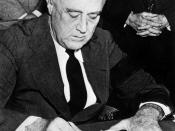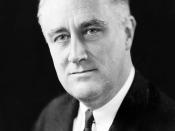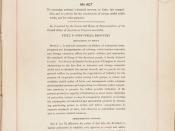During the Great Depression of the 1930s, millions of families were struggling to live on incomes so meager that the threat of starvation hung over them everyday. The great depression had brought millions to unemployment and an increase in poverty. People who remained with their jobs experienced salary cuts and those without jobs lived with the help of friends, family, or just waited out the economic downturn (Freedman 10). The cause and blame of this event happening was while president Herbert Hoover was in office. Once president Franklin D. Roosevelt stepped into office he took matters into his own hands and constructed a series of programs and acts to upturn the economic depression (Fremon 26). The problems people faced during this crisis would take years to overcome.
Unemployment had reached it's highest, one out of every four Americans who wanted work could not find it. Thirty-four million people (28 percent of the population), had no income at all.
Thousands of banks across the country failed and had to close their doors without paying their depositors. People's money which they had worked so hard for vanished over night (Freedman 14).
More than half the nation's young children were growing up in families that could not afford food, shelter, clothing, or medical care. President Franklin D. Roosevelt once said "I see millions of citizens- a substantial part of the whole population- who at this very moment are denied the greater part of⦠the necessities of life. I see one- third of a nation ill-housed, ill-clad, ill nourished" (Freedman 13). People had to wait at soup kitchens run by charities for small portions of dry bread or thin soup, on lines that stretched for many blocks. It was common for people to faint because they hadn't received proper nutrition (Freedman 16-17).
Small poor settlement referred to as "Hoovervilles" sprang up, where the poorest people took refuge. These shack settlements were located on vacant lots and the border of every city. Shelters were built of anything the people could get their hands on such as cardboard, wood, packing crates, fence posts, tin cans, canvas, and anything that could offer them protection from the cold. These communities received their names cause of a bitter tribute to former president Hoover, who was widely blamed for the Depression (Freedman 20-21).
In order to resolve the problems of the Great Depression, during the first 100 days of the new administration, President Roosevelt came up with a plan to help the American people. For the first time, the federal government assumed economic responsibility for the nation. They gave more than $500 million for cash, food, and shelter to the impoverished. These series of programs created by the government were part of what Roosevelt called the "New Deal" (Lisa 28).
The New Deal was created in March of 1933, and ended in the end of the year 1938. The first part of the New Deal was the Emergency Banking Act, which provided for the re-opening of banks under a tight system of licenses and conservators. It also gave the U.S. Treasury the power to make more currency. The government monitored banks to make sure they didn't make unsound loans. After that the Glass Steagall Banking act was passed, this insured that the first 5,000 dollars deposited in a bank by anyone would be guaranteed by the government (Wroble, 59).
Another program, the federal deposit insurance commission insured money in the bank. For example, if the bank closed down while you had any amount of money deposited in the bank the government would return the same amount of money. This bought confidence to people who kept their money else where instead of the bank. The Truth in Securities Act was passed to protect the public from fraud in the issuance of stocks and other securities (Wroble 61).
In the 1920's farmer's were already having troubles due to a surplus in crops which caused a major decrease in the value. Some of the distraught farmers blocked roads to dump milk cans in a desperate effort to force up the price of milk (Freedman 56). The agency called The Agricultural Adjustment Administration sought to reduce staple crops such as corn, cotton, wheat, and tobacco. This would result in charging higher prices for the crops. Other acts passed were the Federal Emergency Relief Act and the Emergency Farm Mortgage Act; these acts loaned money to people in need and helped farmers get back in business (Fremon 70, 91).
The Civil Conservation Corps, CCC, was created and gave young men room and board. They put men from the ages of 17 to 24 to work on beaches, forests, parks, and wildfires, anything short of hard labor. This program paid $30 a month and these men received a room to live in. To earn this they had to work and most of the money they earned was sent to their families. A bill passed in 1933 created the Tennessee Valley Authority, which hired an estimate of 40,000 men to build or improve dams. The project cost $2 billion but it stopped flooding and created electrical power which the government sold at cheap prices (Freemon 92-92).
The biggest and most controversial project of President Roosevelt was the National Industrial Recovery Act. This act consisted of 746 different codes applied to industries to follow. It was to be the "silver bullet" as stated by Roosevelt to stabilize the economy. Section 7A created minimum wages and maximum hours for a person to work. In another section, the government had monopolized businesses even though it rejected the idea of a monopoly. For example, a gallon of milk was to be sold at 10 cents per gallon. Even if a company could profit if they sold the milk at 9 cents, it would be considered illegal. Another example is if the government said to produce a certain number of items and the company produced more, the company risked the chance of being shut down. This brought much bitterness to businessmen throughout the country. The supreme court challenged National Industrial Recovery Act and ruled it unconstitutional and was banned from use by industries (Schraff 64).
There are many differing opinions on how well President Roosevelt dealt with the Great Depression. There were still 8,700,000 Americans still out of work in 1939. Some believe the New Deal created an expensive and complicated bureaucracy that hurt the government for generations. It doubled the national debt in less than two years. Other critics believe that the New Deal helped America keep its freedoms while other countries in the same situation developed tyrannical governments. It did not end the Depression, but saved American democracy. Unemployed were given wages and important work, farmers were saved, and programs like the CCC and NYA helped the young (Schraff 63-70).
The New Deal helped put a stop to the hardships faced by the families of the Great Depression. It provided relief for those who were in need of food and shelter and provided thousands of jobs for the unemployed. The New Deal introduced economic and social reforms that we still use today such as social security, unemployment insurance, minimum wages, maximum hours, housing for low income people, and federally guaranteed saving accounts. All of these things still contribute to a better life for Americans today. Ever since the New Deal, people count on the federal government to protect, help, and guide, the national economy.
Works CitedFreedman, Russell. Children of the Great Depression. New York, NY: Clarion Books, 2005.
Fremon k. David. The Great Depression in American History. New Jersey: Springfield, 1997.
Schraff, Anne E. The Great Depression and the New Deal. New York. Franklin Watts, 1990.
Wroble, Lisa. The New Deal, Great Deal and the Great Depression. New Jersey: Berkeley Heights, 2002.


